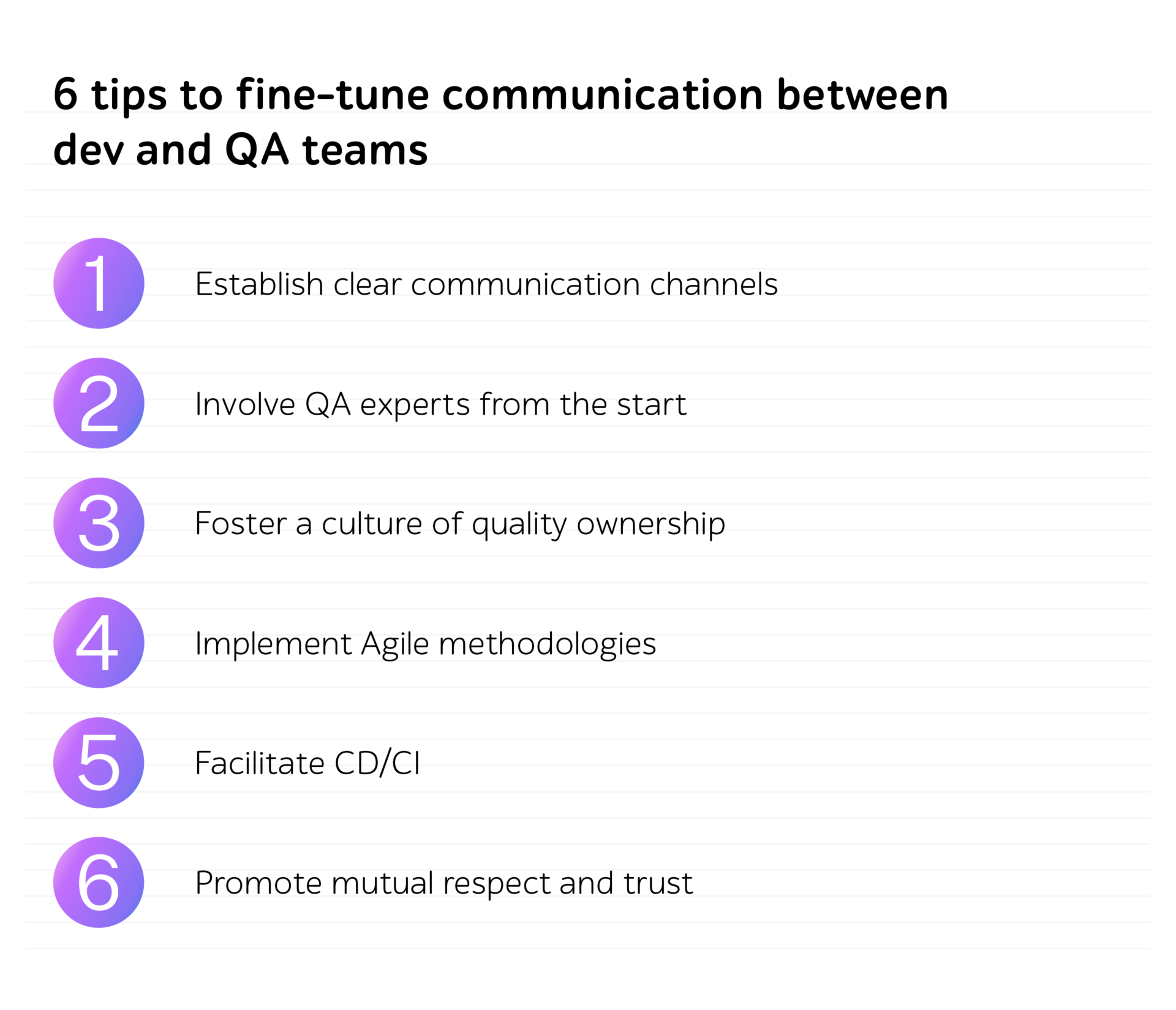
Establishing seamless interaction between development and QA teams to boost productivity
To deliver high-quality IT products, establishing seamless collaboration between QA engineers and developers is paramount.
While QA and development teams may have different focuses and responsibilities, aligning their efforts can help significantly boost productivity and accelerate the release of software solutions.
In this article, we’ll explore 6 practices to ensure smooth operation and foster interaction between these specialists.
Practice 1. Establish clear communication channels
Clear communication channels serve as the foundation of effective interaction between developers and QA experts. Businesses should utilize specialized tools, such as project management platforms, instant messaging apps, and video conferencing software to ensure that teams share updates, discuss requirements, and promptly address arising issues.
To guarantee that both teams are aligned on project goals, timelines, and priorities, it’s critical to define communication protocols, including regular meetings, status updates, and feedback sessions.
However, effective communication goes beyond daily updates — it’s about fostering a culture of transparency, respect, and collaboration. Here are some ways to promote open interaction within QA and development teams:
- Set clear expectations and ensure that team members understand whom to contact in case of concerns, questions, or feedback.
- Value each other’s time and reserve face-to-face conversations for significant issues or discussions requiring immediate attention while using emails or messages for less urgent matters.
- Encourage active listening to ensure that everyone feels heard and valued, leading to better collaboration and problem-solving.
- Support constructive feedback to create a safe environment where specialists feel comfortable providing their opinions.
- Celebrate small achievements and milestones to boost team morale and motivation.
Practice 2. Involve QA experts from the start
Engaging QA teams from the early SDLC stages is key to improving interaction and productivity. By encouraging developers to collaborate with QA engineers during the planning and design phases, companies should identify potential flaws from the ground up, which helps eliminate costly rework and software release delays.
Practice 3. Foster a culture of quality ownership
It’s imperative to dissolve the traditional divide between developers and QA engineers. Responsibility for the IT solution quality should be shared by all team members.
Developers should be accountable for writing robust and testable code. Simultaneously, QA engineers should closely collaborate with them, advocating for quality throughout the entire SDLC, rather than solely serving as gatekeepers.
Practice 4. Implement Agile methodologies
Adopting flexible methodologies, like Scrum or Kanban, can facilitate collaboration between QA and development teams. Agile frameworks promote iterative development, frequent feedback, and continuous improvement, allowing teams to quickly respond to changes and deliver high-quality IT products incrementally.
To synchronize their efforts, identify dependencies, and align priorities, it’s mission-critical to leverage sprint planning, daily stand-ups, and sprint reviews.
Practice 5. Introduce continuous testing
QA plays a crucial role in facilitating CI/CD pipelines by ensuring that code changes integrate smoothly and deploy without errors.
By automating testing processes and implementing robust quality gates, QA teams enable developers to deliver code faster and more frequently. This rapid iteration cycle accelerates the feedback loop and app launch while reducing business risks and boosting the quality of IT products.
Practice 6. Promote mutual respect and trust
Building trust between QA engineers and developers is essential for enhancing productivity. Businesses should create a supportive environment and cultivate a deep appreciation for each other’s contributions within the workplace. To do this, enterprises need to:
- Encourage cross-functional involvement. Foster mutual understanding and respect by encouraging team members to participate in each other’s processes.
- Collaborate as one team. Foster a sense of unity by encouraging QA and development teams to interact as one cohesive unit in problem-solving endeavors. By pooling their talents and resources, professionals can identify and resolve issues more efficiently.
- Emphasize each contribution. Recognize the accomplishments of both QA engineers and developers to foster better communication between teams.

To sum up
Fostering seamless communication between development and QA teams isn’t just a matter of convenience — it’s imperative to attain desired business outcomes during software development projects.
So, how can companies strengthen the interaction between all specialists? It’s critical to establish clear communication channels, involve QA experts from the start, cultivate a culture of quality ownership, implement Agile methodologies, facilitate CD/CI, and promote mutual respect and trust.
Contact a1qa’s team and obtain support in releasing top-notch software solutions at speed.








